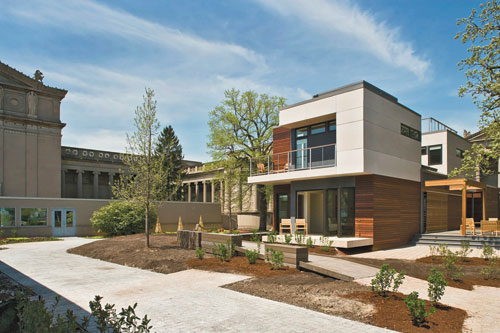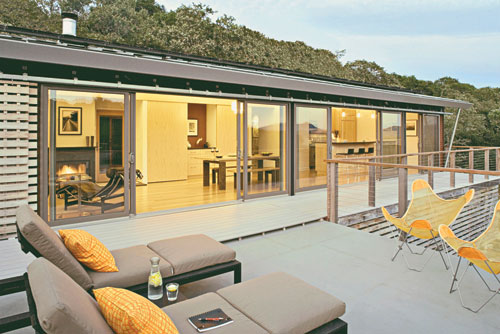Prefabrication's Green Promise
Architecture firm KieranTimberlake Associates has a more radical vision for prefabrication, believing that it could remake the construction industry in the style of the aircraft or automotive manufacturing industries. In this vision, a number of factories could construct portions of a home as stock parts and then deliver them either to a central factory or to the site, where they would be assembled. Although it's not clear how the details of this model would work, it could take advantage of the efficiencies of prefabrication while offering aesthetic and site-specific options.
KieranTimberlake has begun experimenting with this model of prefabrication, incorporating elements of panelized and modular construction into its Loblolly house on Taylors Island in Maryland. The 2,200-square-foot house features an aluminum structural frame that was created to order and assembled on site. The frame holds floor and wall panels, called "cartridges," that contain the electrical and plumbing runs needed for the home, including a radiant floor heating system. Modules containing the bathrooms and the mechanical room arrived on site fully constructed and were lifted into place by a crane. Exterior wall panels included interior finishing as well as insulation, windows, and exterior cladding. The house was assembled in six weeks on site, and can be disassembled quickly with simple tools. Parts of the house can be reused, while others are designed to come apart for easy recycling and disposal.
Â
  |
|
The mkSolaire from Michelle Kaufmann Designs is designed for urban-infill development and passive ventilation. (top), Michelle Kaufmann's first residential project, the Glidehouse, features passive-solar design and comes wired for photovoltaics (bottom). Photos courtesy John Swain |
Â
 |
Place Houses in Seattle offers customizable green kit homes (that look something like the model pictured), which arrive prewired for photovoltaic systems. Photo courtesy PLACE ARCHITECTS |
Â
Making the Promise a Reality
To realize the environmental benefits of prefabrication, designers may need to combine elements, joining panelized construction with modular components and site-built finishes to create a structure that best meets the needs of the site and the client. As the industry continues to respond to client demand and green leadership, finding a manufacturer willing to work with green specifications will become easier. The promise of green prefabrication may soon become a reality.Â
Â
Â








